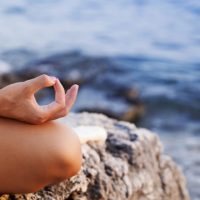What is the Best Type of Yoga?

A COMPARISON OF HATHA AND VINYASA YOGA PRACTICES
Yoga has taken America by storm in the last couple of decades. Two very popular forms of yoga, Vinyasa and Hatha, dominate most yoga studios. While the two practices aim at the same goal, which is to prepare the body for meditation, they each approach it differently. While technically, Vinyasa yoga is derived from Hatha yoga, the practices are quite different.
Vinyasa Yoga
The form of yoga called “vinyasa” is a sequence of flowing movements and postures combined with rhythmic breathing. Vinyasa is best practiced with a focus on the body’s alignment to ensure that you do not injure yourself and so that you can make the most out of your practice.
To fully experience vinyasa yoga, you should observe your mental and physical habits – and learn to recognize them. You should also practice releasing your mind from the focus on thought as you move through and then remain in the asanas. By doing so, you allow vipassana, which means ‘clear seeing.’ Flow, precision, and mindfulness of yoga bring you into this state of vipassana.
These principles are founded on the Buddhist philosophy called Maitri (loving-kindness) and the yogic philosophy of ahimsa (non-harming). The idea is that you transition into a receiving state with your heart and your lungs. Both give and receive with each pulse and breath.
The idea behind mindfulness is to become aware that we are impulsive beings who act before thinking. By implementing mindfulness, we create a buffer zone between our impulses and our actions. This buffer gives us time to refine and temper our actions with kindness.
The interaction between our bodies and our minds is a type of conversation, and it is representative of the things that occur in all other types of relationships – fondness, apathy, annoyance, and dissatisfaction. Because most of us tend to use our appearance and health of our physical body to identify our “selves,” being able to observe this conversation in a way that is both maitri (loving-kindness) and ahimsa (non-harming) gives us a good footing for whatever turns up as we focus inward.
As we face our reactions to holding an asana or pose, we see clearly that we have habits – we are either too tense or too relaxed, too meticulous or too lax in our attention to posture. These habits mirror our state of mind, body, and speech. When we recognize our habits, it is known as “right action,” which is comprised of cadence, movement, direction, energy, and intention. It is important to note that right action should never include aggression.
Buddhists find that meditation is helped tremendously through yoga because their bodies become stronger, more fluid, and more functional. Instead of feeling one’s back or knees ache while seated for meditation, the Buddhist yogi can focus on being mindful and compassionate.
Yogis who wish to draw from the Buddhist teachings can learn to become more aware, less negatively biased towards themselves and others, and more connected to all things. They also learn mastery over the physical body because they feel this connection in whatever asana they find themselves – and they come to understand the transient nature of all things.
Hatha Yoga
Hatha yoga is another form of yoga that helps to bring inner focus. It is commonly referred to as “forceful” yoga because it ‘forces’ the body to reconcile both masculine and feminine. These are Eastern concepts of masculine and feminine, not Western ones.
Masculine aspects, known also as ‘hot’, ‘active’, or ‘sun’, commonly referred to as ‘yang’ forces are one side of two polar opposites. The other side of that is ‘yin,’ which is feminine, meaning ‘cool’, ‘receptive’, or ‘moon.’ Literally, the term “hatha” is from two ancient Sanskrit words – “ha”, which means ‘sun,’ and “tha,” which means ‘moon.’
Like Vinyasa yoga, Hatha yoga is a preparation for comfortable meditation. Hatha yoga is focused primarily on asanas, or poses, rather than flowing movements like one finds in Vinyasa. Hatha yoga is often taught as ‘beginner yoga’ in the west, because there are no complicated transitions between poses. It is a more relaxed form of yoga.
Which type of yoga is better for you?
Some people consider Vinyasa yoga a more ‘advanced’ form of yoga because it requires a lot of concentration and strength to move in and out of poses. Other people believe that Hatha yoga is more ‘advanced’ because when you pay attention to each and every pose, which may be held for longer periods, you tend to find mental challenges arise – an intended bringing forth of personal struggle if you will.
Regardless of which form of yoga you choose, if you practice regularly, you will find that it relaxes your body and your mind and brings you into the present rather than focusing on everything going on around you.
References
- Jensen, Pernille B., et al. “Yoga for Adolescents with Functional Somatic Symptoms: A Randomized Controlled Study.” National Library of Medicine, 2015, https://www.ncbi.nlm.nih.gov/pmc/articles/PMC4660831/.
- Ross, Alyson, and Sue Thomas. “The Health Benefits of Yoga and Exercise: A Review of Comparison Studies.” National Library of Medicine, 2010, https://www.ncbi.nlm.nih.gov/pmc/articles/PMC3193654/.
- Wheeler, Allison, and Deborah Wilkin. “A Study of the Impact of Yoga on Health in a General Population Sample.” National Library of Medicine, 2007, https://www.ncbi.nlm.nih.gov/pmc/articles/PMC2907973/.
- Chong, Chit Kang, et al. “Effects of Yoga on Stress Management in Healthy Adults: A Systematic Review.” National Library of Medicine, 2011, https://www.ncbi.nlm.nih.gov/pmc/articles/PMC3193654/.
- Cramer, Holger, et al. “Effects of Yoga on Mental and Physical Health: A Short Summary of Reviews.” National Library of Medicine, 2013, https://www.ncbi.nlm.nih.gov/pmc/articles/PMC3549435/.
- Saper, Robert B., et al. “Yoga for Chronic Low Back Pain in a Predominantly Minority Population: A Pilot Randomized Controlled Trial.” National Library of Medicine, 2009, https://www.ncbi.nlm.nih.gov/pmc/articles/PMC2887499/.
- Kirkwood, G., et al. “Yoga for Anxiety: A Systematic Review of the Research Evidence.” National Library of Medicine, 2005, https://www.ncbi.nlm.nih.gov/pmc/articles/PMC3063408/.
- Riley, Kristin E., and Benjamin L. Park. “Yoga and Psychotherapy: Can Yogic Practices Be Integrated into Psychological Practice?” National Library of Medicine, 2015, https://www.ncbi.nlm.nih.gov/pmc/articles/PMC4445174/.
- Field, Tiffany. “Yoga Clinical Research Review.” National Library of Medicine, 2011, https://www.ncbi.nlm.nih.gov/pmc/articles/PMC3193654/.
- Sherman, Karen J., et al. “Comparing Yoga, Exercise, and a Self-care Book for Chronic Low Back Pain: A Randomized, Controlled Trial.” National Library of Medicine, 2005, https://www.ncbi.nlm.nih.gov/pmc/articles/PMC3063408/.




